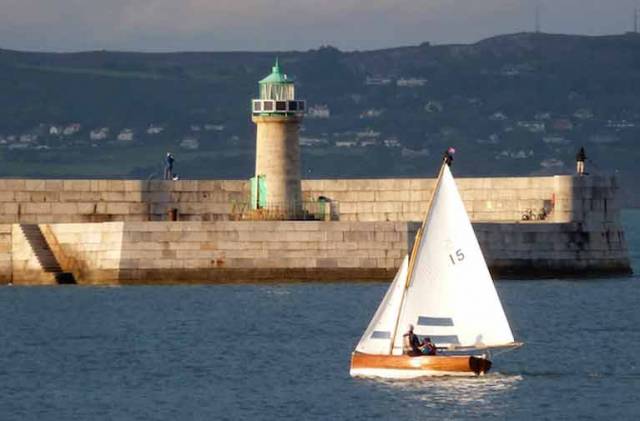The rapidly-developing partnership between solo offshore veteran Alex Thomson and proven star of fully-crewed boats Nin O’Leary of Cork has been the focus of much attention this week as they visit Cork and Dun Laoghaire.
Thomson’s eye-catching IMOCA 60 Hugo Boss was leader for significant stages in the 2016-2017 Vendee Globe Race, and placed second at the finish in January. During August, his linkup with Crosshaven’s Nin O’Leary and the new Cork-based set–up of Ireland Ocean Racing has had the rumour mills running in overdrive, with much speculation and comment. W M Nixon found that the unique position of Dun Laoghaire provided a special occasion and a relaxed setting in which the prospects for this new and dynamic sailing relationship could be quietly and usefully discussed.
Every so often, the rest of us who sail from other ports are reminded that, in the final analysis, Dun Laoghaire is our sailing capital. Cork Harbour may be very much the national maritime centre, with Galway also making notable research input. But the extensive nature of Cork Harbour is such that it has several places and organisations which could claim to be its main focal point, so the effect is diffused. And while Galway successfully punches way above its weight, the fact that as a city it is only a fraction of the size of Dublin inevitably counts in rating its influence.
Thus Dublin is very much the capital, the place where major decisions are taken in all national areas including the maritime sphere. Dublin Bay is the main area for its sailing, well ahead in the numbers game. And Dun Laoghaire is uniquely the focal point for that sailing, a remarkable and historic artificial harbour through which the pulsing metropolitan energy interacts with the sea and recreational seafaring.
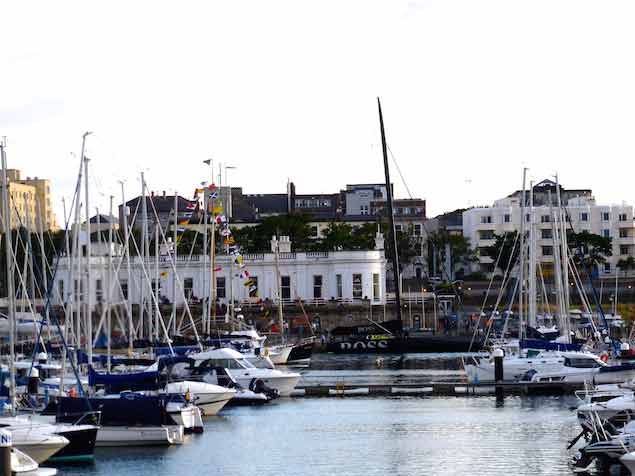 The brooding presence. The all-black IMOCA 60 Hugo Boss berthed at the Royal Irish Yacht Club. Photo: W M Nixon
The brooding presence. The all-black IMOCA 60 Hugo Boss berthed at the Royal Irish Yacht Club. Photo: W M Nixon
Yet at a different level, it is also the home port of many hobby sailors who simply see it as the conveniently-located local harbour which has ample facilities for their own sailing needs. Admittedly the affluence of the area in which it is located has meant that Dun Laoghaire has seen a significant influx of new non-woooden boats over the years, and it has lost some of the historic local One-Design classes which were once the bedrock of its highly-developed sailing scene. But even here, once it became clear that an important heritage was under threat, there has been a growing movement to preserve and expand the most historic class of all.
That has succeeded with the current great good health of the Dublin Bay Water Wag, the world’s first One-Design class, which started life as a simple double-ended little slip of a lug-rigged 13ft sailing dinghy in 1887, but by 1900 was in process of changing itself into a heftier transom-sterned gunter-sloop-rigged clinker-built boat 14ft 3ins long and 5ft 3 ins beam, with a heavy centreplate.
The new design commission was entrusted to boatbuilder J. E. Doyle in what was then Kingstown, but it’s generally reckoned the real designer was his daughter Maimie Doyle, whose talent lay in putting manners on her father’s extremely rough and often nonexistent sketches.
Whatever the design origins, the new boats were soon popular. But with other larger One-Designs available locally, each with its own adherents, it was thought good going if the racing turnout for the new Water Wags climbed above the fifteen mark before the Great War of 1914-1918.
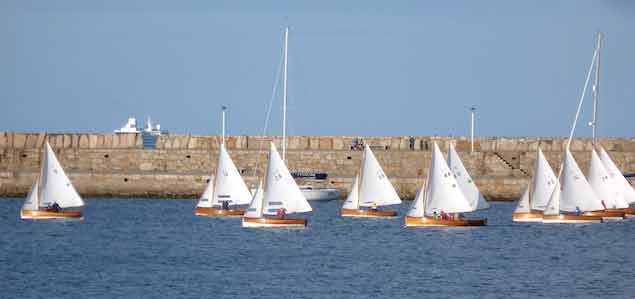 Race on! The Water Wags and Dun Laoghaire Harbour seem made for each other. Photo: W M Nixon
Race on! The Water Wags and Dun Laoghaire Harbour seem made for each other. Photo: W M Nixon
Dublin Bay proved to be ideal for the encouragement of several One-Design classes, but over the years the classic larger wooden boats left the stage to be replaced by more modern plastic boats, with the Dublin Bay 21s exiting in 1986, while in 2004 the Dublin Bay 24s sailed their last race, yet today it could be argued that they’ve been replaced by the growing Dublin Bay J/109 fleet.
A couple of post-World War II timber-built classes are still active in the Glens and the IDRA 14s, but the 17ft Dublin Bay Mermaids of 1932 provenance which originated in Dun Laoghaire are only a token presence, even if they thrive elsewhere. So now the main thrust of Dun Laoghaire enthusiasm for genuine classics sailing has devolved on the Water Wags, which today prosper as never before, and in 2017 with noted maritime historian Hal Sisk as the very active Class Captain, it was hoped they might finally achieve a racing turnout of 30 boats on the starting line.
One hundred and thirty years to become an overnight success? It could only happen in Dun Laoghaire. But as the Water Wags have been such a key part of the sailing fabric of this great harbour for so long, those in the know were well aware that the evening of Wednesday 30th August was the date set for the very special big push, the extra effort towards topping the thirty mark with the racing for the Captain’s Prize, with the fleet including helms and crews with Olympic experience.
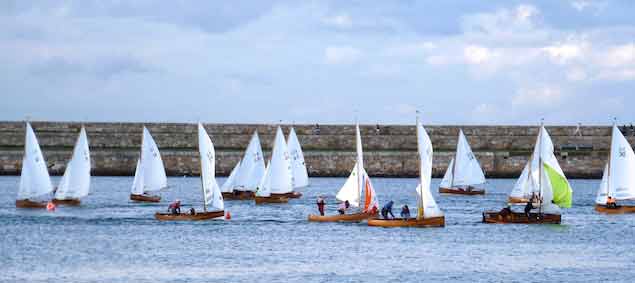 With the class rules’ insistence that spinnakers be set classical style entirely to weather, speed of setting varies enormously. Photo: W M Nixon
With the class rules’ insistence that spinnakers be set classical style entirely to weather, speed of setting varies enormously. Photo: W M Nixon
That racing in turn would be rounded out by a dinner held in the Captain’s own club to end the season’s evening racing. The Water Wags’ home bases are spread along the three older waterfront clubs, so the Captain’s Prize dinner 2017 was already scheduled for Hal’s own club, the Royal Irish, when news emerged that the mighty Hugo Boss, with the new Thomson/O’Leary combo on board, hoped to visit Dun Laoghaire for a couple of days in the last week of August, and could the RIYC accommodate their promotional needs to be seen, be accessible, and provide a base for shore entertainment?
The visit would clash either with the Water Wags special race on Wednesday, or with the regular big-turnout Dublin Bay Sailing Club keelboat racing on Thursday. It fell to the RIYC’s Rear Commodore (House) Jacqueline McStay to decide how to play it, and she played a blinder.
Where others saw a problem, she saw an opportunity. She suggested that the planned dinners for the Water Wags and those involved with Hugo Boss should be turned into one single free-form event, using the RIYC’s historic dining room and spreading into the drawing room next door. She further suggested that as the Water Wags had seniority, Hal Sisk should be the main – indeed, possibly the only - speaker at the actual dinner.
But then, with a touch of genius, she suggested that while the Water Wags were out racing, it would be ever so obliging if Alex, Nin, and their genius boffin-organiser Stewart Hosford could give a little presentation to an audience of members and friends, in the club’s extensive basement room, about themselves, their own plans, and the boat’s movements in the weeks, months and maybe years ahead.
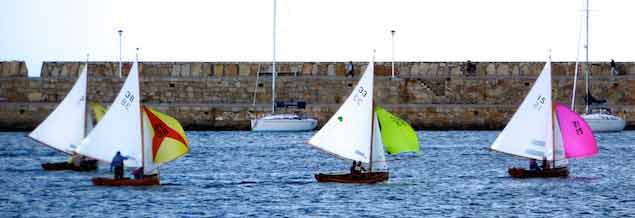 The leaders begin to emerge from the pack, with eventual winner Moosmie leading from Eva (33, Katie Tingle & Dermot O’Flynn), Swift (38, Guy Kilroy, sailed by David Somerville) and Pansy (3, Vincent Delany) Photo: W M Nixon
The leaders begin to emerge from the pack, with eventual winner Moosmie leading from Eva (33, Katie Tingle & Dermot O’Flynn), Swift (38, Guy Kilroy, sailed by David Somerville) and Pansy (3, Vincent Delany) Photo: W M Nixon
It was a masterplan for non-stop nautical entertainment for about six hours, beginning with the sniff around the Hugo Boss (“mighty machine” is an inadequate phrase here) followed by seeing the early stages of the Water Wags’ historic race, then breaking away to take in the presentation by the Talented Three in the basement, followed by the dinner when history and modernity got together, with the enjoyment of this providing a relaxed atmosphere for the exchange of information.
Pessimists would reckon this complex programme for one night in one club had endless opportunities for the wheels to come off, but it went so well you’d swear they did this sort of thing at least five nights a week. As with all Irish events of an outdoor/indoor nature, the Great Imponderable was the weather, and the forecast 24 hours earlier wasn’t at all cheerful. Yet despite that they managed to rouse out a world record of 31 “new” Water Wags, and the photos say everything about perfect conditions for the last evening race of the summer.
 A shared harbour. Trainee crew out for the evening with St Michael’s Rowing Club.Photo: W M Nixon
A shared harbour. Trainee crew out for the evening with St Michael’s Rowing Club.Photo: W M Nixon
It also provided ideal circumstances for a consideration of the current condition of Dun Laoghaire. The place isn’t helped by being in a state of limbo. I’d optimistically hoped that I could get a good shoreside overview of the race by somehow getting myself to the end of St Michael’s Pier at mid-harbour, but it’s still all blocked off as they battle back and forth about the provision or otherwise of a liner berth.
In other words, the shoreside of the harbour is basically inaccessible to the public except down the marina breakwater, but even that limited viewpoint showed that this was a race in a million. And the quality of construction of the main harbour is such that it’s a joy to behold on such an evening, while within it the Water Wags shared the space with skiffs of St Michael’s Rowing Club and boats out from the Irish National Sailing School. Conditions improved as the race went along, with a freshening breeze sharpened up by a long black cloud which moved slowly over towards Howth, leaving crisp evening sunshine behind it, and a markedly veering breeze for the final beat of a four leg windward-leeward course.
 Moosmie (15) seems to have it nicely under control going over to the tricky west side of the harbour…….Photo: W M Nixon
Moosmie (15) seems to have it nicely under control going over to the tricky west side of the harbour…….Photo: W M Nixon
 ……but finds herself at the weather mark temporarily behind Swift (38, Guy Kilroy sailed by David Somerville) and Pansy (3, Vincent Delany) Photo: W M Nixon
……but finds herself at the weather mark temporarily behind Swift (38, Guy Kilroy sailed by David Somerville) and Pansy (3, Vincent Delany) Photo: W M Nixon
 Moosmie clear ahead again. Photo: W M Nixon
Moosmie clear ahead again. Photo: W M Nixon
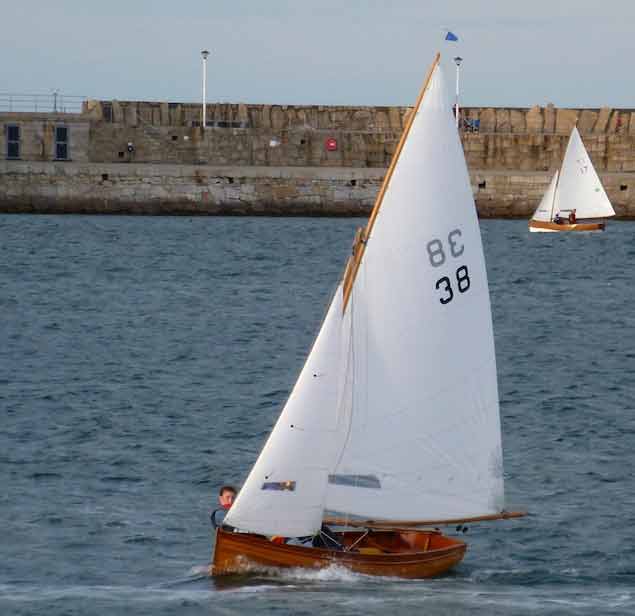 Modern sail-making materials have greatly improved the appearance of the Water Wags. With cotton sails, they often had a starved look, but today’s sailplan looks well fed. This is Guy Kilroy’s 2001-built Swift raced on Wednesday to fifth place by David Somerville. Photo: W M Nixon
Modern sail-making materials have greatly improved the appearance of the Water Wags. With cotton sails, they often had a starved look, but today’s sailplan looks well fed. This is Guy Kilroy’s 2001-built Swift raced on Wednesday to fifth place by David Somerville. Photo: W M Nixon
Thus although David and Sally MacFarlane in the 107-year-old Moosmie (no 15) had overcome a setback or two to retain the lead and sometimes show well clear ahead, the finish came with a bit of a rush of boats in from the right hand side of the beat. While Cathy MacAleavey and Con Murphy were second across in her new Mariposa, finish signal came there none - they’d been OCS. But it was the night of nights for the class’s only Howth owners, Ian & Judith Malcolm with the 102-year-old Barbara. They’d been 21st round the leeward mark, but went onto port and headed straight at that black cloud sitting plumb over their house on the southwestern flanks of the Hill of Howth.
They got themselves a mighty freeing for the tack to starboard, and came roaring in toward the finish picking off places by the handful, and finding that the leaders for much of the race were in a bit of a tangle towards the line. So they weathered the lot of them and swept in to take a neat second, making it non-Dun Laoghaire sailors in two of the top places for this Race of Races, as Katie Tingle of Cork was third and winner of IB with Eva, crewed by Dermot O’Flynn.
 Back to base. Hugo Boss waiting to welcome William Prentice & Moiselle Hogan’s Tortoise (42, built 2006, placed 4th) and winner Mousmie (built 1910) as they return to the Royal Irish YC. Photo: W M Nixon
Back to base. Hugo Boss waiting to welcome William Prentice & Moiselle Hogan’s Tortoise (42, built 2006, placed 4th) and winner Mousmie (built 1910) as they return to the Royal Irish YC. Photo: W M Nixon
 Help is always welcome when hauling a Water Wag on the slip, even at high water. Photo: W M Nixon
Help is always welcome when hauling a Water Wag on the slip, even at high water. Photo: W M Nixon
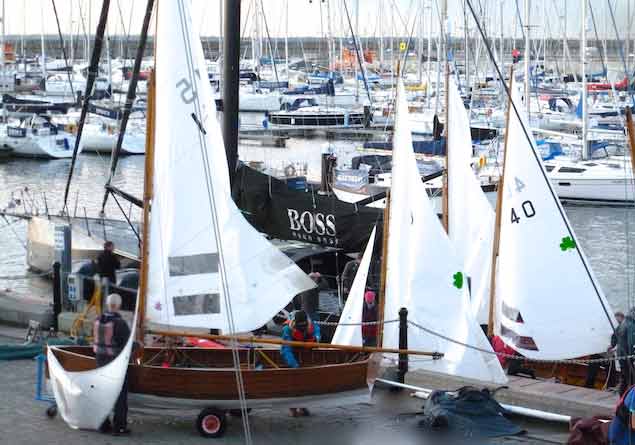 The perfect evening. The winner Moosmie (foreground) is un-rigged after being the first to win from 30 other boats, and Hugo Boss is there to see it all happen. Photo: W M Nixon
The perfect evening. The winner Moosmie (foreground) is un-rigged after being the first to win from 30 other boats, and Hugo Boss is there to see it all happen. Photo: W M Nixon
It’s a good idea to do well in the racing, as it lessens your queuing time to get up the club slips. The atmosphere around the Water Wags is so basically light-hearted – even when they’re hauling these quite heavy little boats back up the slip – that it took a while to adjust to the next mood-stage of the evening, the underlying utter seriousness involved in racing an IMOCA 60 like Hugo Boss, and particularly in such totally extreme sport as the Vendee Globe Race. Alex Thomson does a wonderful line in light-hearted patter, but what he does is mind-blowingly all-involving, and as he talked us through the financial, physical and most importantly psychological requirements for anyone even beginning to contemplate such a thing, you were left in bewilderment in grasping the scale of it all.
As to the matter of how and why he moves about the boat without being apparently concerned about being directly attached to her, he created a certain silence by saying that as you’re often sailing at 25 knots, going overboard on the end of a wire or something similar would bring the certainty of getting dragged to a particularly nasty drowning death.
Only a hundred or so people have managed to sail round the world non-stop, so there’s a real sense of community among those who have done it, and they in turn respect those who have made a whole-hearted attempt to do the same. A real high-point came when Enda O Coineen burst out of the audience and went forward to present his old mate Alex Thomson with a replacement cap for one which had been exchanged a long time ago.
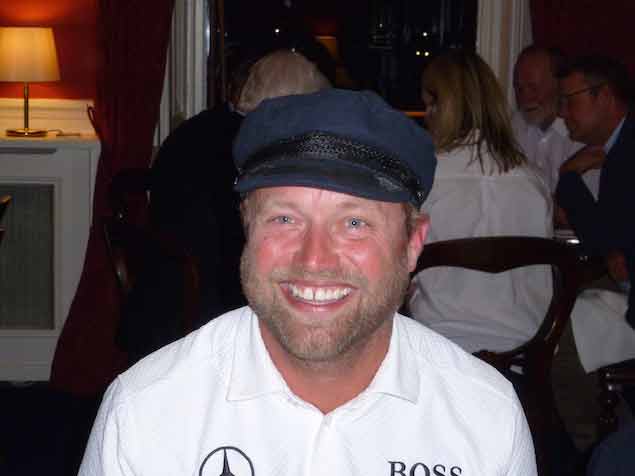 Alex Thomson with his new cap from Enda O Coineen. Photo: W M Nixon
Alex Thomson with his new cap from Enda O Coineen. Photo: W M Nixon
Stewart Hosford didn’t quite bewilder us with science, but he has such mental energy that there are times you think he’s operating on a different planet, while as for Nin O’Leary, he talked of their hopes and how he is finding it all coming together - or not. He faces a monumental challenge.
Certainly fund-raising is something that all these sailing superstars seem to gravitate towards pretty quickly, and it was in the Water Wags/Hugo Boss dinner afterwards that we could ask real questions, for the gathering in the basement room had been a pubic presentation and emphatically not a press conference. Come to that, nor was the dinner either, but things gets said across a table, and an early revelation from a notable Man Who Knows in the RIYC was that the next America’s Cup will be in skinny 73ft monohulls with enormous canting keels, which would seem to indicate that the Alinghi man who was the real backer of Team NZ is carrying the day.
Then, in his Water Wag Class Captain’s speech, Hal Sisk was in fine form, handing out the prizes with style, and taking the opportunity to present Alex Thompson with his fascinating book which convincingly argues that Dublin Bay was the cradle of modern yacht racing. Knowing that Baghdad was the cradle of civilisation, I’m not too sure that being the cradle of anything is necessarily a good thing for future prospects, but doubtless the book will have a special place in Hugo Boss’s on-board library.
As a very pleasant evening wore on, the talk became more relaxed, and in chatting about the lack of Fastnet Race success, Nin O’Leary confirmed that the construction of Hugo Boss is so specialised that any modification to fit ordinary dagger boards instead of foils would be prohibitively expense, and of limited use in hitting the overall target of a boat designed specifically for Vendee conditions, which are 90% offwind.
Thus in that frustrating upwind slog from Land’s End to the Fastnet, when holding on port tack was soon the only choice because of the huge Traffic Separation Zone, they were making ten degrees of leeway. And once they finally got to the Fastnet, there just weren’t enough miles left in getting to Plymouth to take more than one place in the IMOCA 60 class.
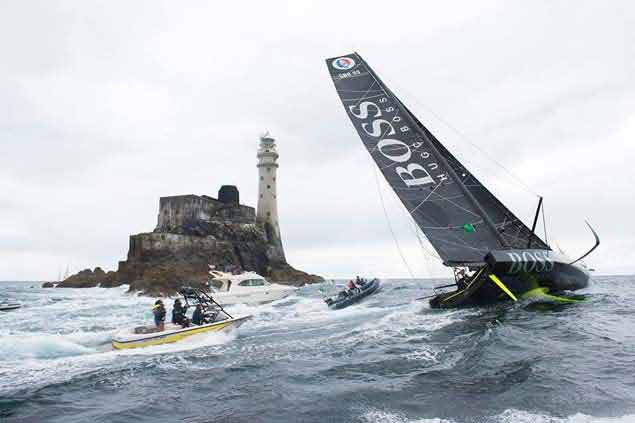 Hugo Boss with the fan club as she arrives at the Fastnet. The extreme offwind foil configuration means she makes about ten degrees of leeway when hard on the wind
Hugo Boss with the fan club as she arrives at the Fastnet. The extreme offwind foil configuration means she makes about ten degrees of leeway when hard on the wind
The problem is that with such a purpose-designed boat, the number of useful events is limited. In the interim, between races which suit, they have to make do with what’s available, so their next outing will be the Middle Sea Race on 28th October. The winds in that are notoriously all over the place, but who knows, they might get lucky, and it’s all experience even though they’re allowed to carry extra hands. But it won’t be more than three at most, as more bodies just get in the way in a cockpit optimised for one.
For Alex Thomson, the Hugo Boss sponsorship, with major support from Mercedes, is in place for 2020, but his team are willing to take in any extra interest, as the boat we were being amazed by at the Royal Irish cost a basic of €5 million, and a new one won’t be any cheaper. As for Nin O’Leary, he seems to be aiming for a boat he can initially secure for €3.6 million, but will need continuing investment thereafter.
 Stewart Hosford and Nin O’Leary
Stewart Hosford and Nin O’Leary
You cannot but be intrigued by the Hugo Boss setup. The boat looks and is the quintessential expression of modern German industry and commerce. Yet she’s sailed by a jolly Englishman whose main performance theatre is provided by France. And the technical management behind it all is provided by a peripatetic Corkman.
Into this whirling maelstrom of possbilities and challenges has stepped a 31-year-old Irish sailing star who is learning just as fast as he can by sailing as co-skipper on Hugo Boss, yet the logic is that he in time will have to think of his own boat. In fact, everybody is taking a very mature approach to this. The only relative certainty is that they’ll be doing the Middle Sea Race together in eight weeks time. Beyond that, the ideal might be the two-handed Barcelona World Race in May 2018, but if Nin O’Leary has his own boat by that time, then he’ll be going with that, and Alex Thomson will have to find another co-sailor.
It’s a world of long-term goals in which you have to be prepared for changing situations from minute to minute, or even second to second. We’re astonished by the sheer challenge of the big events, without thinking of the shoreside work. The bigger the sponsorship, the more demanding the sponsor will expect to be of the star’s time.
Set against the innocent amateur sport of Water Wag racing, the contrast was total. You really couldn’t have asked for a better way of grasping the enormity of what these guys take on.



























